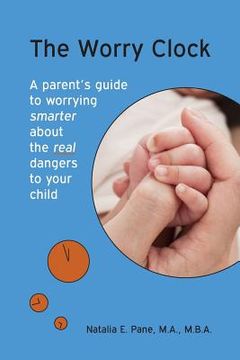The Worry Clock: A Parent's Guide to Worrying Smarter about The Real Dangers to Your Child (en Inglés)
Reseña del libro "The Worry Clock: A Parent's Guide to Worrying Smarter about The Real Dangers to Your Child (en Inglés)"
We hear a lot of statistics about dangers to children, but how do parents know where to focus instead of being afraid of everything and turning into "helicopter parents," those excessively overprotective parents? The Worry Clock: A Parent's Guide to Worrying Smarter about the Real Dangers to Your Child, puts all the dangers into context, shows which are most dangerous, and gives ideas on what to do about it. The book reveals some startling information on when to-and not to-worry about children, including: - Electrical outlets are less deadly than most parents probably believe. Two and a half times as many children age one to four were killed by dogs as died by falling down steps or sticking something in an outlet, but all three were extremely rare. - Parents should think twice (or more) about where an infant sleeps. Infant deaths from rebreathing and other forms of suffocation account for more deaths than all causes for the next four years (ages 1-4). Mom is probably right that she won't roll over on the child, but babies are vulnerable to many other dangers in adult beds and couches. - Drowning in a home pool is particularly dangerous for toddler boys. Drowning is the most common cause of death for toddlers and is particularly dangerous for the youngest boys, who were last seen in the house and were under a parent's supervision. - Teenage driving is the #1 worry across your child's life. Teen driving should be the number one focus of your attention and new drivers getting driving practice-without other teens in the car-is the best way to help your teen survive. - A baby's inconsolable crying is common, but it is also a frequent cause of homicide, the #2 killer of infants. Children's cries might be manageable to you, but make sure they are for your caregivers, too, because homicide of toddlers linked to crying is very high and estimates are that 11-20 percent of shaken baby syndrome is perpetrated by the babysitter. As the title suggests, this book gives parents the data to worry smarter. And readers don't need to know statistics to read it. A "Worry Clock" is presented for each age group: infants (up to 1), toddlers (1-4), young children (5-9), preteens (10-14), teenagers (15-19), and all ages together (0-19). The Worry Clock uses a one-hour clock to show how much time you would spend worrying about specific causes of death if you based your worry on data. During the infant year, for example, about thirty minutes, or half of your worry, would be on making sure your child sleeps safely. Overall, there is good reason for parent activism; at least one-third of the childhood deaths are from what most would agree are preventable incidents, such as drowning or suffocating. Child abduction, parents' reported greatest fear, is addressed in the last chapter. - Stereotypical child abduction, parents' worst fear, is extremely rare and happens primarily to older, not younger kids. The average age of abduction is around 10-11, the age caregivers start thinking they have made it past this worry and often occurs within three blocks of the house. This book and the statistics within offer some fuel for regaining rationality-what to worry about, why, and how to reduce the danger-while providing the opportunity to regain sanity by not sweating the unlikely, truly bizarre, or simply unpreventable.

